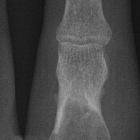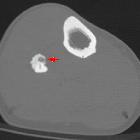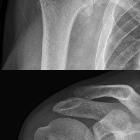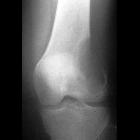Epiphyseal lesions (differential)

Epiphyseal
lesions (differential) • Giant cell tumor - Ganzer Fall bei Radiopaedia
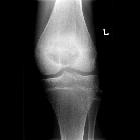
Epiphyseal
lesions (differential) • Chondroblastoma - distal femur - Ganzer Fall bei Radiopaedia

Epiphyseal
lesions (differential) • Hip osteoarthritis - Ganzer Fall bei Radiopaedia

Epiphyseal
lesions (differential) • Osteomyelitis of the humerus - Ganzer Fall bei Radiopaedia
Epiphyseal lesions comprise tumors and other pathologies that occur around the epiphysis and any epiphyseal equivalent bone.
Differential diagnosis
Common differential diagnoses include the following :
- chondroblastoma: rare epiphyseal tumor found in young adults; it usually does not extend into the metaphysis, and usually does not extend beyond the bone
- giant cell tumor (GCT): occurs in adolescents in whom the epiphyseal growth plates have closed; it can extend to involve the adjacent metaphysis
- geode/intraosseous ganglion
- osteomyelitis
- clear cell chondrosarcoma
- others that occur rarely
- osteosarcoma and osteoblastoma
- aneurysmal bone cyst (ABC): usually metaphyseal, but if it occurs after the growth plate is obliterated, it may extend into the epiphysis
- brown tumor
- haemophilic pseudotumor
- enchondroma
- eosinophilic granuloma
- osteoid osteoma
See also
The more common of the above entities may be recalled with a mnemonic: epiphyseal lesions (mnemonic).
Siehe auch:
- Osteomyelitis
- Osteoid-Osteom
- Aneurysmatische Knochenzyste
- Osteosarkom
- Enchondrom
- intraossäres Ganglion
- Arthrose
- Chondroblastom
- Riesenzelltumor
- subchondrale Zysten
- Osteoblastom
- skeletale Manifestationen der Langerhanszell-Histiozytose
- Knochenläsionen der Epiphyse
- Ostitis fibrosa cystica
- klarzelliges Chondrosarkom
- Knochenläsionen der Diaphyse
- Knochenläsionen der Metaphyse
- epiphyseales Equivalent
- epipheseal lesions
und weiter:

 Assoziationen und Differentialdiagnosen zu osseous lesions preferentially involving the epiphysis:
Assoziationen und Differentialdiagnosen zu osseous lesions preferentially involving the epiphysis:skeletale
Manifestationen der Langerhanszell-Histiozytose


